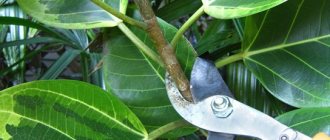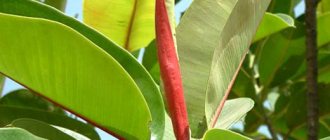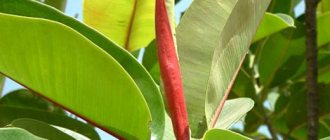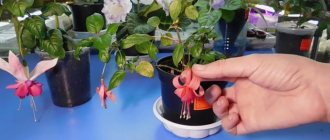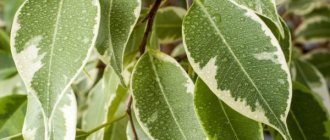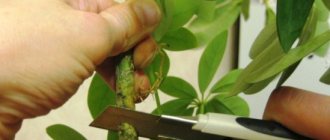Why is pruning needed?
Beginning flower growers are interested in whether partial removal of branches will harm an overgrown bush? Pruning is done to form a beautiful lush crown of the ficus.
Ficus rubbery
Periodic cutting of dry and damaged branches helps keep the plant healthy. Disease prevention includes timely removal of damaged processes. If this is not done, the infection may spread to the entire bush.
Correctly performed manipulation contributes to:
- rejuvenation, restoration of indoor plants;
- formation of a beautiful crown.
Trimming time and tool preparation
How to prune hydrangea correctly in spring and whether it should be pruned
Partial removal and shortening of individual parts, carried out at a time of vigorous growth, will help make the ficus crown voluminous and fluffy.
Trimming tools
A specific period is recommended for each type of pruning. The formation of the crown is carried out from early spring to mid-summer. How to properly form a ficus at home, why can’t you remove parts of branches and foliage in winter?
A popular species among Russian plant growers is the rubber ficus, pruning of which is strictly prohibited from January to March. Coming out of dormancy, the plant begins to sprout shoots from the side where the branches were cut. The bush becomes skewed to one side.
Note! New shoots are formed from the reserves of nutrients left over from the fall. This is harmful to the bush. Actively growing new branches weaken the houseplant.
Do not prune immediately after transplantation. The ficus flower is still undergoing adaptation, and pinching and removing shoots will cause additional stress. After transferring the bush to another pot, you need to perform sanitary pruning.
In the process of forming a bush they use:
- pruner;
- gardening scissors;
- sharp knife (scalpel).
Before manipulation, you need to prepare antiseptic agents:
- garden var;
- alcohol;
- Activated carbon.
Instruments are disinfected with alcohol-containing products and calcined over a fire. Cuts on the trunk and branches are treated with garden varnish. Removal of unnecessary processes is carried out with a sharpened knife. It is impossible to carefully cut off an unnecessary shoot with a blunt instrument. The bark will be “torn” at the cut site. Pathogenic bacteria can enter the trunk through the injured area.
Garden var
Useful tips for growing
- When pruning ficus, do not leave stumps - fungi can grow in them.
- Wipe the area of the fresh cut with a damp cloth until the juice flow stops.
- Immediately after finishing work, wipe tools stained with ficus milk with a cloth soaked in alcohol.
- Flower shops sell special vaccinations that stimulate the growth of ficus.
- If ficus juice gets on your body, rinse the area thoroughly with water.
General rules for pruning ficus
Removal of healthy branches can only be done during the period of active growth. Before this, the plants need to be fed with nitrogenous fertilizers two weeks before.
How to trim a climbing rose for shaping
Some types of ficus stop their vertical growth by pinching the single central stem. Usually, instead of one trunk, several shoots appear. The rubber ficus does not form lateral branches after pinching.
Sections are made above the kidneys in a horizontal direction. Branches are cut close to the stem. Tall stumps spoil the appearance of the flower. Over time, these short sticks dry out and become a breeding ground for fungi and pests.
It is important to know! Thick woody branches are removed at an angle of 45 degrees, and thin green shoots should be cut straight.
The milky juice is removed from fresh ficus wounds with a cotton swab, then the damaged areas are treated with crushed activated carbon and garden pitch. These measures will disinfect the cut and protect the ficus from infection.
The milky sap of ficus is very thick. If the instruments have been calcined and wiped with alcohol, the wounds on the bark do not need to be treated with varnish and charcoal. When the juice dries, it clogs the cut. Therefore, pruning of rubber ficus can be carried out without antiseptics.
The knife and other items that were used during pruning are thoroughly washed immediately after the manipulation. If this is not done, the frozen juice will be difficult to remove.
How to prune ficus correctly
A lush crown of a ficus is obtained if the shoots are regularly pinched. Pinching the growth points of branches results in the active growth of new side shoots.
Preparing ficus for pruning
In order not to spoil the indoor flower as a result of pinching, the bush is inspected before manipulation. They select weakened, unsightly shoots and think over the shape that should be obtained as a result of processing. The buds located below the branch cuts will become the growth site for future lateral branches.
Additional Information! New shoots will grow in the directions where the buds are directed.
With regular pinching, the size of the leaves decreases. The leaf blades on the side branches have a smaller area than those growing on the central stem.
Features of growth
A guest from Southeast Asia, Ficus Elastica, is a large tree, reaching up to 50 meters in height and, thanks to its aerial roots, sometimes growing into entire groves. It has a strong trunk, and its aerial roots, going down to the ground, form something like columns, eventually forming a banyan tree. The largest banyan tree has 250 main supports and 3,000 small ones.
In indoor conditions, this plant does not reach such sizes, but it can easily grow from 60 centimeters to 1 meter in a year. Under favorable conditions, ficus elastica grows one leaf per week, without shedding old leaves.
On the elliptical, pointed, large sheets of elastica, a milky sap sometimes appears, containing enzymes, latex, and alkaloids that protect it from pests and serve for regeneration. When it comes into contact with human skin, it causes dermatitis and irritation.
Considering that the plant stretches in height, practically without bushing on its own, it is necessary to artificially limit its growth by pruning and pinching the upper shoots. In this case, there is no need to transplant the elastica into a pot that is too spacious.
Pruning to rejuvenate the plant
To give new vitality and restoration, it is recommended to trim all damaged branches. Anti-aging pruning is carried out when the plant has been frostbitten or has begun to dry out due to illness.
How to prune Kalanchoe correctly
If the ficus has lost its foliage after hypothermia and the top has begun to die, pruning it to the stump can help. An indoor flower, having gotten rid of the diseased part, will quickly recover due to young growth that will come from living roots. In this way it will be possible to rejuvenate the ficus cariana (fig).
If desired, you can leave a few shoots and grow the flower in the form of a bush. Typically, gardeners select the strongest stem, cut out the surrounding shoots, and then form the plant into a small tree. The choice of shape depends on personal taste.
Note! If you want to get a lot of shoots again, remove them; after a while, root sprouts will appear from the ground. Dwarf ficus trees respond well to such manipulations.
Sick, drying flowers are subjected to radical pruning. Remove all damaged branches. Only 2 buds are left. The cut material is used for cuttings. Long branches are shortened so that there are 4 buds left on them. Two are buried, the remaining ones are left above the soil surface. All sections are pre-treated with activated carbon.
Pruning to rejuvenate the plant
Basic methods
When caring for an indoor ficus, two main pruning must be done - sanitary and rejuvenating.
Sanitary
The procedure is usually carried out in the spring, before the start of active growing season, or in the fall, in preparation for the dormant stage.
Old branches become a place for pests and pathogenic bacteria to settle. All damaged and drying shoots must be removed down to healthy tissue. The shoots that have dried to the ground are cut back to the root.
Rejuvenating
Pruning helps the plant grow
The procedure is necessary in the following cases:
- the indoor flower has reached its age limit and is not producing new branches;
- the ficus was affected by an infectious disease and after treatment healthy areas remained;
- The above-ground part of the plant froze, but the root system survived.
Anti-aging pruning consists of completely removing the above-ground part, after which only the central trunk remains.
Dwarf varieties tolerate a radical haircut at the base. In other subspecies, up to 2 buds are retained on the branches - they are needed for planting fresh cuttings.
Sanitary pruning
Dry, broken branches, leaves that have begun to turn yellow are removed throughout the year. Poorly developed, diseased shoots should not be left; they spoil the appearance and can become a source of infection for the entire plant.
The flower is periodically inspected. On some varieties of deciduous ficus, the branches become bare after September. Diseased areas can be detected after they have entered a dormant state. Each unhealthy sprout is removed immediately after it is discovered. Pruning is done regularly.
Old and diseased branches become food for fungi. Gradually decomposing, such areas attract pests. Larvae are laid on them. Diseased shoots growing from the soil are removed to the very root.
Formation of the crown and general appearance
The beautiful appearance and fluffiness of the crown are formed in the process of regular painstaking work. The shape of the apical part of the flower is planned in advance. You need to determine how tall the ficus will be. It is important to understand right away whether it will be a standard plant or a fluffy bush. The owner of the flower himself decides how to form the ficus.
When there are too many internal shoots, the crown can be thinned out. They leave buds that are directed not along the trunk, but outward. If the task is to form a round crown, leave an equal number of branches directed horizontally and vertically. The shoots are pruned in a circle, at an equal distance from the point marked in the center.
Formation of the plant crown includes:
- pruning of apical shoots;
- shortening side branches;
- direction of the processes in a certain direction.
Bending and fixing is done using wire, ropes, and pegs. Branches growing in the wrong direction are aligned and secured with tension devices. It is not always necessary to cut off healthy strong shoots at the root. It is better to give them the desired shape. There is no guarantee that the new branches will grow evenly and strong enough.
You can give the desired direction if you bend the branch away from the central trunk; just secure it at the required distance using a spacer or slingshot.
Note! To avoid damaging the bark, foam rubber, cotton wool, or fabric are placed under the tip of the stick.
The crown formed in the form of a ball or cone looks beautiful. The apical part of the ficus can be cut in the form of any geometric figure. Several shoots form a single intertwined trunk with a common crown. Such a tree will decorate an office or home winter garden.
To form a trunk, all shoots are pruned, except for the five apical ones. When the ficus has grown to the desired height, pinch the central stem, then shorten all the branches that have grown beyond measure in a circle. Such manipulations are possible only with young plants.
Creating unusual shapes
The standard ficus looks beautiful, but many novice gardeners do not know how to form its crown. Some ficus trees are grown as small trees. Most of the trunk trunk is freed from side branches. The apical part of the plant is given any geometric shape.
There are interesting options for forming an intertwined single trunk from root shoots. As it grows, several shoots intertwine.
Additional Information! Over time, the stems grow together. To create a single trunk, any braiding pattern is used.
To braid a ficus, you should wait until the shoots grow upward. Young, non-woody shoots can be formed. Depending on the amount of material, you can create weaving in the form of:
- spirals;
- hedge (wattle fence);
- gratings;
- braids.
Unusual trunk shapes
An important design rule. The more complex the shape of the trunk, the simpler and more natural the apical part should look. On a simple single stem, the crown looks harmonious, having the shape:
- spheres;
- cone;
- hemispheres.
How to prune a house ficus so that it is fluffy, the owner makes a decision after a thorough examination of the branches and the location of the buds. If the gardener plans to create a single plant from several shoots, they need to be shortened at the same height. Stems with side branches removed are suitable for weaving. Pinching the apex activates the lateral buds. If the manipulation is carried out regularly, the ficus will form a beautiful lush crown.
Ficus weave
The most common and simplest way to shape a trunk is a pigtail. There are also methods such as “spiral” (using 1 plant) and “lattice” (6-7 copies are needed), but they are less popular or require experience and are not suitable for novice gardeners.
Braiding step by step:
- plant 3 cuttings without side branches, about 15 cm each, in one flowerpot at a short distance from each other;
- after rooting, carefully make 1 turn of the braid, securing it with a woolen thread just above the plexus;
- continue normal care of the plant until it reaches a length that allows you to make another turn;
- When the braid reaches the desired height and there is no need for further weaving, it must be secured with a metal bracket or wire.
During weaving, you need to monitor the degree of fixation - too weak will not give results, excessive will damage the trunk.
Activities after pruning
It is impossible to grow a beautiful indoor plant without quality care, which includes:
- regular watering with warm water;
- balanced feeding;
- protection against viruses, bacteria and pests.
Feeding for ficus
Before and after forming the flower, you need to apply fertilizing. To quickly recover, the plant needs nutrients and careful loosening of the soil. When the plant is actively growing, nitrogen fertilizers are chosen.
Important information! Pure organic matter cannot be added. Compost and manure tincture are disinfected. Infection is often introduced with homemade homemade fertilizers.
To avoid pest infestation, ficus leaves can be periodically irrigated with infusion of garlic and onion. This potion is also suitable for watering crops. It is used simultaneously as protection and foliar feeding.
It is not recommended to replant indoor flowers after pruning. Additional stress can cause fragile bushes to die. When transshipment, too long, diseased, rotten roots are removed.
With the right integrated approach to plant care and protection, and high-quality regular pruning, a lush crown is formed. When there is a ficus in the house, how to form a crown is a secondary question. The unpretentious culture tolerates removal and pinching of branches well.
Aftercare
Pruning a ficus is a stressful situation that weakens the plant and requires adaptation. To do this, you need to provide proper care:
- organize regular watering with small volumes of water, avoiding drops falling onto fresh cuts;
- temporarily stop foliar spraying;
- avoid hypothermia and exposure to drafts;
- fertilize no earlier than 2 weeks from the date of pruning.
Processing slices
To avoid the penetration of pathogenic microorganisms through open wounds, all trimmed stumps from the bush should be treated with disinfectants, for example, crushed charcoal or activated carbon. The cut areas can be covered with garden varnish.
